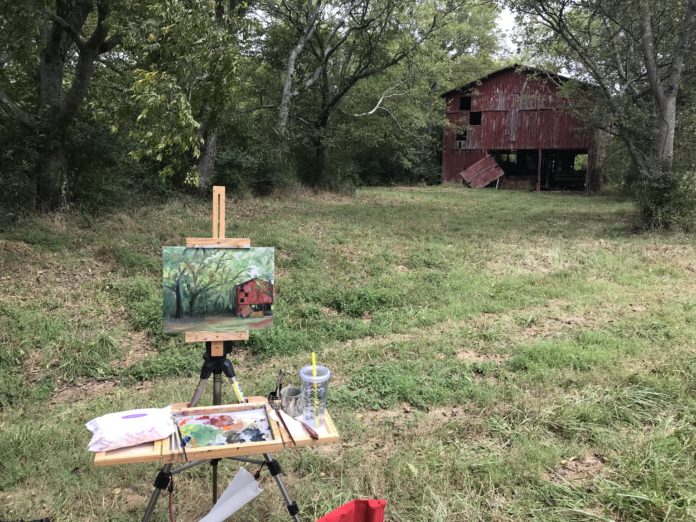
If you’re still in the early phases of your art journey, you’ll appreciate these practical nuts and bolts for the beginning artist.
by Mary Carol Johnston
It might seem presumptuous for a newbie artist such as myself (I’ve been painting for only four years!) to offer advice for other artists, but who would know better what a beginning artist is going through than someone who has recently been through the beginning phases herself? This isn’t about technique, craft, or voice. It’s about the practical nuts and bolts of getting started as an artist. So, for those of you who are just embarking on your art journey, here are my suggestions to make the road a little smoother and more enjoyable.
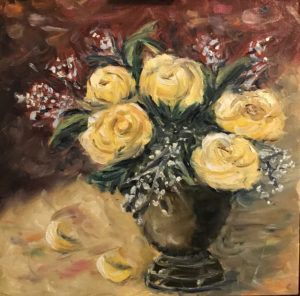
This painting hits all the points in my artist’s statement. It has great sentimental value to me, there’s a little whimsy, and it’s connected to important people (my 96-year-old mother), places, and experiences in my life.
1. Create an Artist’s Statement. I know . . . having an artist’s statement sounds all hoity-toity. However, I can tell you that it makes a BIG difference! Even for an absolute beginner! Your vision as an artist is what drives everything else. Writing an artist’s statement helps you solidify your focus and purpose in painting. It will keep you from wasting time on things that don’t fit your vision. Post your statement where you can see it when you paint. I wrote about my process in creating an artist’s statement here. Remember: Your statement is not written in stone! Your art and your statement will change, and that’s a good thing because it shows that you’re growing as an artist.
2. Gather the materials you will need. Nothing will kill your desire to paint more than having a great painting idea but not having the materials to follow through. Many times, by the time you gather the materials, that inspirational spark has fizzled. Make sure your materials include a sketchbook that’s small enough to carry around with you so you can make quick sketches when you find yourself in a waiting room or with time on your hands.
3. Set up a dedicated space for painting inside as well. You need a space for art and nothing else. You won’t paint much if you must clear away papers, dishes, or toys every time you want to paint. It can be a table in the corner of your bedroom, a desk in the kitchen, an easel set up in the laundry room, a spare bedroom, space in your garage, or anywhere that you can create an area just for your art. Make sure you have a place to keep your supplies.
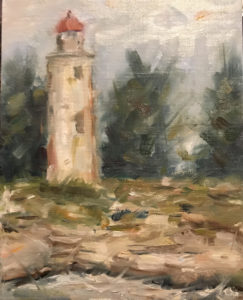
I painted this over two years ago in a workshop led by Derek Penix. I was the only amateur artist in the small class. Talk about feeling intimidated and vulnerable! I was in WAY over my head but muddled through and learned so much. I still use what I learned from Derek about “fracturing” lines.
4. Take workshops and/or lessons from a variety of artists. Check out community centers, ask other artists, call your local arts council, get online to research, call nearby colleges and universities, or check the arts section of your local newspaper to find out what is available nearby. Then sign up for an art workshop that most closely matches your own interests.
When you take a workshop, go in with an open mind. You’re there to learn. Embrace the experience — follow the instructor’s suggestions — try out new techniques and materials — use the instructor’s palette — take notes. When you go home after the workshop, practice what you learned. Keep what works for you. Discard what doesn’t. Even nationally recognized artists take workshops in order to keep learning and growing. One caveat, though. Don’t become a workshop junkie and use workshops as a substitute for painting independently!
5. Get involved in the art community. There is a thriving art community just about everywhere — local all the way to international. In the few years that I’ve been painting, I’ve added an entirely new dimension to my circle of friends and experiences. Here are some suggestions for involvement. Choose what appeals and is available to you.
a. Join local art groups and get involved. Volunteer to help with art shows and paint-outs. You don’t have to be an accomplished artist to be active in the art world. Does your community have “art crawls” each month? Start small and make decisions about your involvement based on your artist’s statement. Will this group help me reach my goals? Is this group’s vision in line with mine?
b. Subscribe to and read art magazines. It’s fun and instructive to read about all the shows, conventions, and galleries and to see the art that other people produce.
c. Join artist groups on Facebook, Instagram, and other social media, and “friend/follow” other artists. Artists generally post their work, and you can see what other artists are doing. If someone posts a painting you like, leave a comment telling them why you like it. That helps to build relationships.
d. Join associations such as the Outdoor Painters Society, American Impressionist Society, and Oil Painters of America. Find groups for the medium(s) you use. Associations offer information, videos, workshops, paint-outs, and competitions. They provide opportunities to network and learn. They also sponsor shows that give you the opportunity to submit your art for consideration.
e. If you’re interested in plein air painting (painting outdoors), then do your best to attend the annual Plein Air Convention and Expo (PACE). You’ll be with hundreds of other artists and have dozens of well-known artists that provide sessions about various elements of painting. Participate in as many of the sessions and activities as you can.
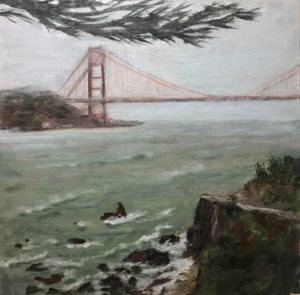
I painted this at PACE19 in San Francisco. As I walked along the cliff afterward, I looked at the hundreds of painters scattered around painting different scenes. I looked at the bay, the bridge, and I thought, “I LOVE this!” That is the feeling you want when you paint!
6. Be patient. When I started painting, I wanted to be a great painter IMMEDIATELY! I wanted to instantly know how to mix colors and how to paint in the style of impressionism. It doesn’t happen that way, though. You’re embarking on a marathon — not a sprint. As you continue to paint, you WILL improve, and you WILL learn. It is through this process that you will develop your voice as an artist.
7. Embrace your vulnerability. I can’t stress enough how important this is! When you paint, you are baring your soul and heart. It can be painful to put your art out there where others can comment and pass judgment on it. Your every doubt and insecurity marches to the forefront. Don’t let your vulnerability paralyze your art, though. Remember: Different people = different styles of painting. It can be intimidating to go to that first (or hundredth!) workshop where you paint in front of people and where a professional artist/teacher (gasp!) will critique your art. Embrace the fact that you’re human and not perfect. It’s okay to be a beginning artist with much to learn.
I deliberately use the word “embrace” rather than “accept” because embracing indicates enthusiasm. It’s a good and valuable thing to be vulnerable. Go ahead and post your paintings on your Facebook, Instagram, and Pinterest pages. You are you, and there’s no one else that will paint like you.
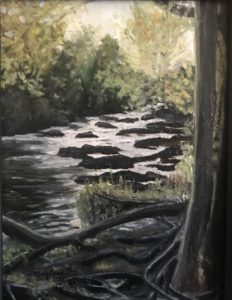
I participated in a six-day plein air workshop at Arrowmont School of Arts and Crafts in Gatlinburg, TN, taught by my now good friend, Rachael McCampbell. This is a painting of the Little Pigeon River, started en plein air and finished in the studio.
8. PAINT Do your art and don’t let anything stop you. You may know one or two people that talk about being an artist, but they never get around to actually painting. Don’t let that white canvas or panel intimidate you! You are the boss of your art! Set a doable goal and then do it! The simple act of starting a painting is often all that’s needed to get you going. It doesn’t have to be perfect. That’s the beauty of art. You can always wipe off the paint or paint over it. The more you paint, the better you’ll paint. And painting simpler subjects/scenes repeatedly will enable you to hone the skills to paint more difficult subjects/scenes. I repeat: You are the boss of your art! So, get busy art-ing!
9. ENJOY the journey! Painting will change your life. You will never look at clouds, trees, flowers, or even an apple the same way again. You will never see a white cloud again because now your newly awakened “artist eyes” will see all the purples, reds, browns, and oranges that are in those previously plain white clouds. You’ll gain a new vocabulary and start talking about cast shadows, local color, values, chroma, saturation, and shapes. You’ll become an obsessive photographer, always aware of the need to get shots of scenes you might want to paint someday. You’ll start looking for the less obvious or hidden scenes that capture your artistic attention. This is a lovely and healthy way to live — with a heightened awareness of the beauty of the world around you, the textures and colors and intricacies of nature.
Being an artist is a calling, a calling to journey through this life being more observant, more caring, and more intuitive. A calling to embrace your imperfections, explore your world, and translate your deepest thoughts and emotions into color on a canvas. Enjoy the journey.
About Mary Carol Johnston: Many years ago, when Carol had to write and illustrate a children’s book as an assignment when taking a Children’s Literature class, she realized that her art wasn’t easy! In one of her illustrations, a river appeared to be coming out of the sky. Carol decided then that the art fairy had not bestowed the gift of art on her, and so she turned her creative efforts into being the queen of crafts instead — sewing, macrame, quilting, knitting, pottery, ceramics, crocheting, making prayer beads and jewelry, painting rocks, stained glass, fused glass, etc. If it’s a craft, Carol has probably tried it at least once. She also channeled creative energy into writing — keeping journals, maintaining blogs, and having human interest stories published in local and national publications.
When she retired after 30 years of teaching, she finally had the time and resources to concentrate on what she had always dreamed of doing — painting. She took a deep breath, gathered her courage, and signed up for a class. She learned that, with guidance and instruction, she COULD learn to paint. Not Michelangelo or Kathy Odom worthy, but not totally awful either. Thus she joined the legions of retired folks who have found joy and wonder in art.
When a painting is particularly meaningful to Carol, she writes poetry to accompany it. Carol says, “Embracing your vulnerability is the key to growing as an artist.”
Connect with Mary Carol Johnston:
Website | Facebook
Visit EricRhoads.com to find out all the amazing opportunities for artists through Streamline Publishing, including:
– Online art conferences such as Plein Air Live
– New video workshops for artists
– Incredible art retreats
– Educational and fun art conventions, and much more.
> Subscribe to Plein Air Today, a free newsletter for artists
> Subscribe to PleinAir Magazine so you never miss an issue


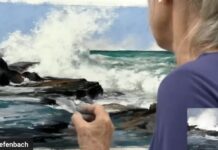


This is SO inspirational!! Thank you, Mary!
Thank you, Rose. 👍
Thank you, this piece is such great advice. We all have “vision statement” inside of us. Whether in our personal life or our professional life. As a newbie I still feel overwhelmed. I want to “try it all”, all media forms and styles.
I see by creating an Artist Statement I will have some form of direction.
The artist’s statement has really helped me! Thanks, Tony!
Very enjoyable to read this- you remind us all how to keep perspective in this long journey of painting. Plus your energy and enthusiasm come through, and is inspiring!
Thanks, Judy!
[…] watercolor artists need encouragement, tips and effective tools to stay with this lovely medium. Have you ever heard someone say “I tried […]
Thank you for your clear, en pointe, writing. First as someone who has been painting on and off for 3 years, you gave me permission to call myself a “beginner”. When I have to think still about which brush or which tube to pick up, I consider myself a beginner. I also found number 6 very relevant. I like the concept of a marathon rather than a sprint. I love the process of painting. But I need to remind myself that a quickly finished product is not the goal. And number 7; this may be the hardest of all, exposing myself ie my work to other people for comment or judgement. A class is hard. But I don’t usually know or have a relationship with the class mates. Showing to friends or even family is really hard. And then knowing how to process some of those well meant suggestions comments. Ah yes I have a long way to go. But your writing hit home with me. Thank you.
Excellent article containing great advice. I read your full article on writing an artist’s statement, and it has been on my mind the past few months. Recently I sold my first painting so I now feel an urgent need to take your advice to heart. I appreciate the breakdown of the process greatly; it makes a lot of sense and makes it seem really doable. Thank you so much for sharing.
Doug
Great article! I believe your tips will be very useful for beginners! Gonna show it to my niece who started painting recently
I think 6 and 7 tips, to be patient and embrace your vulnerability, are the most difficult ones here, no matter how talented you are and how well everything is going. Sooner or later all artists face them. And your article is very helpful! Thanks for your time and great tips.
I like how you mentioned that your vision as an artist drives everything else. My sister is wanting to become a professional sculpture artist once she gets her degree from the university she is attending. My sister is going to have to figure out what her vision is so that she can know what she wants to accomplish as an artist.